check engine light Citroen NEMO DAG 2008.5 1.G Owner's Manual
[x] Cancel search | Manufacturer: CITROEN, Model Year: 2008.5, Model line: NEMO DAG, Model: Citroen NEMO DAG 2008.5 1.GPages: 140, PDF Size: 2.17 MB
Page 18 of 140
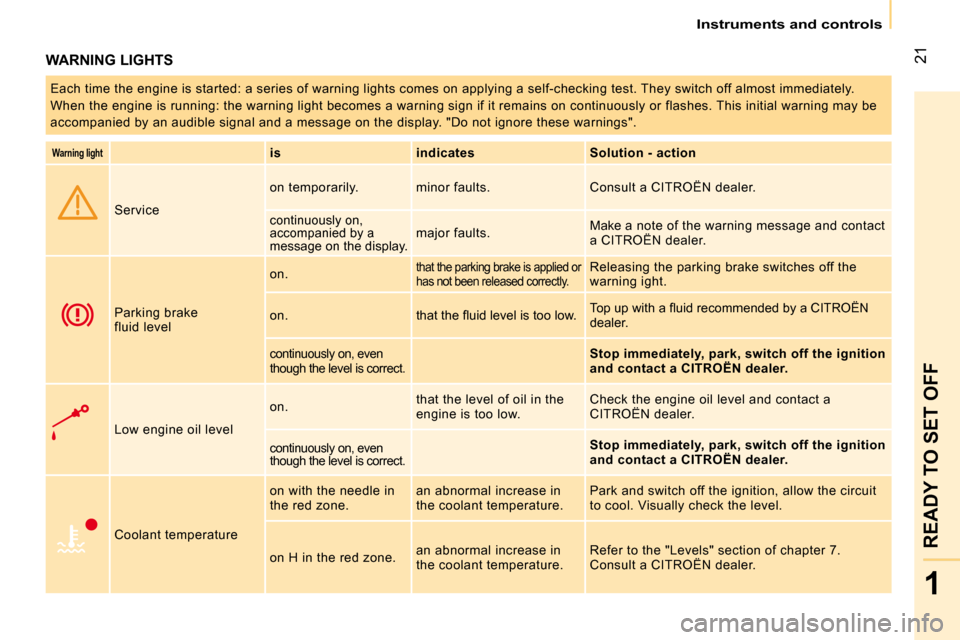
21
1
READY TO SET OFF
Instruments and controls
WARNING LIGHTS
Each time the engine is started: a series of warning lights comes on applying a self-checking test. T hey switch off almost immediately.
When the engine is running: the warning light becom es a warning sign if it remains on continuously or flashes. This initial warning may be
accompanied by an audible signal and a message on t he display. "Do not ignore these warnings".
Warning light
is indicates Solution - action
Service on temporarily. minor faults. Consult a CITROËN
dealer .
continuously on,
accompanied by a
message on the display. major faults. Make a note of the warning message and contact
a CITROËN dealer .
Parking brake
fluid level on.
that the parking brake is applied or
has not been released correctly. Releasing the parking brake switches off the
warning ight.
on. � �t�h�a�t� �t�h�e� �fl� �u�i�d� �l�e�v�e�l� �i�s� �t�o�o� �l�o�w�.� � �T�o�p� �u�p� �w�i�t�h� �a� �fl� �u�i�d� �r�e�c�o�m�m�e�n�d�e�d� �b�y� �a� � �C�I�T�R�O��N�
dealer .
continuously on, even
though the level is correct.
Stop immediately, park, switch off the ignition
and contact a CITROËN dealer .
Low engine oil level on.
that the level of oil in the
engine is too low. Check the engine oil level and contact a
CITROËN dealer .
continuously on, even
though the level is correct.
Stop immediately, park, switch off the ignition
and contact a CITROËN dealer .
Coolant temperature on with the needle in
the red zone.
an abnormal increase in
the coolant temperature. Park and switch off the ignition, allow the circui
t
to cool. Visually check the level.
on H in the red zone. an abnormal increase in
the coolant temperature. Refer to the "Levels" section of chapter 7.
Consult a CITROËN dealer .
Page 19 of 140
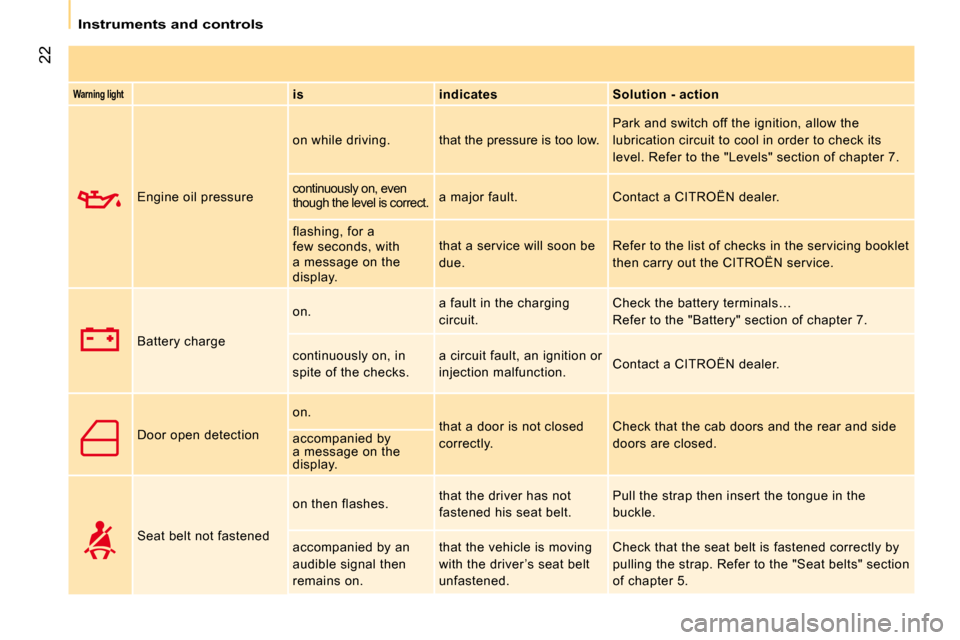
22
Instruments and controls
Warning light
is indicates Solution - action
Engine oil pressure on while driving. that the pressure is too low.
Park and switch off the ignition, allow the
lubrication circuit to cool in order to check its
level. Refer to the "Levels" section of chapter 7.
continuously on, even
though the level is correct. a major fault. Contact a CITROËN dealer .
flashing, for a
few seconds, with
a message on the
display. that a service will soon be
due.
Refer to the list of checks in the servicing bookl
et
then carry out the CITROËN service.
Battery charge on.
a fault in the charging
circuit. Check the battery terminals…
Refer to the "Battery" section of chapter 7.
continuously on, in
spite of the checks. a circuit fault, an ignition or
injection malfunction.
Contact a CITROËN dealer .
Door open detection on.
that a door is not closed
correctly. Check that the cab doors and the rear and side
doors are closed.
accompanied by
a message on the
display.
Seat belt not fastened on then flashes.
that the driver has not
fastened his seat belt. Pull the strap then insert the tongue in the
buckle.
accompanied by an
audible signal then
remains on. that the vehicle is moving
with the driver ’s seat belt
unfastened. Check that the seat belt is fastened correctly by
pulling the strap. Refer to the "Seat belts" sectio
n
of chapter 5.
Page 25 of 140
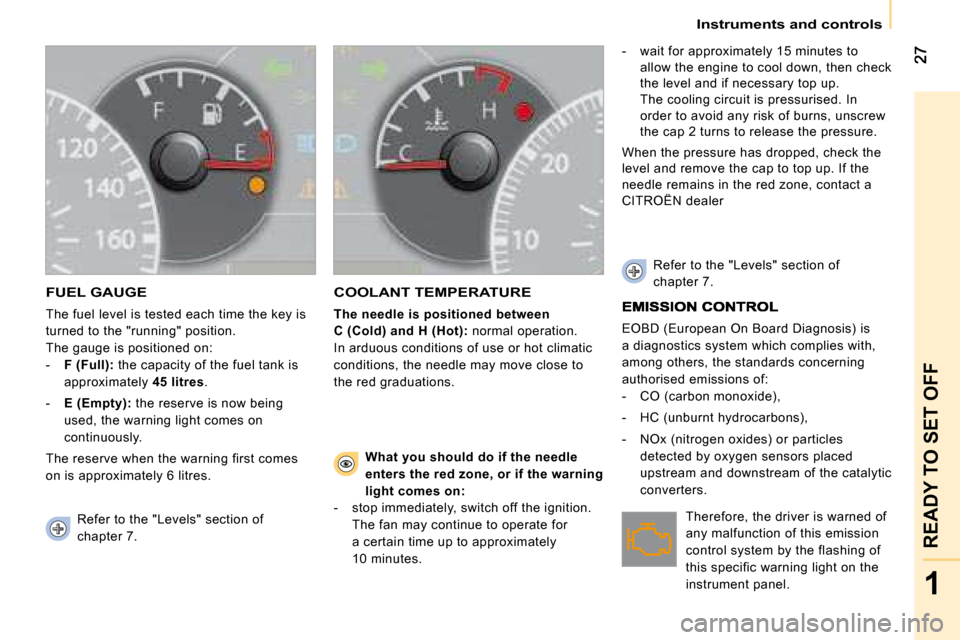
1
READY TO SET OFF
Instruments and controls
FUEL GAUGE
The fuel level is tested each time the key is
turned to the "running" position.
The gauge is positioned on:
- F (Full): the capacity of the fuel tank is
approximately 45 litres .
- E (Empty): the reserve is now being
used, the warning light comes on
continuously.
The reserve when the warning first comes
on is approximately 6 litres.
COOLANT TEMPERATURE
The needle is positioned between
C (Cold) and H (Hot): normal operation.
In arduous conditions of use or hot climatic
conditions, the needle may move close to
the red graduations. - wait for approximately 15 minutes to
allow the engine to cool down, then check
the level and if necessary top up.
The cooling circuit is pressurised. In
order to avoid any risk of burns, unscrew
the cap 2 turns to release the pressure.
When the pressure has dropped, check the
level and remove the cap to top up. If the
needle remains in the red zone, contact a
CITROËN dealer EOBD (European On Board Diagnosis) is
a diagnostics system which complies with,
among others, the standards concerning
authorised emissions of:
- CO (carbon monoxide),
- HC (unburnt hydrocarbons),
- NOx (nitrogen oxides) or particles detected by oxygen sensors placed
upstream and downstream of the catalytic
converters.
Refer to the "Levels" section of
chapter 7. Refer to the "Levels" section of
chapter 7.
Therefore, the driver is warned of
any malfunction of this emission
control system by the flashing of
this specific warning light on the
instrument panel.
What you should do if the needle
enters the red zone, or if the warning
light comes on:
- stop immediately, switch off the ignition. The fan may continue to operate for
a certain time up to approximately
10 minutes.
Page 26 of 140
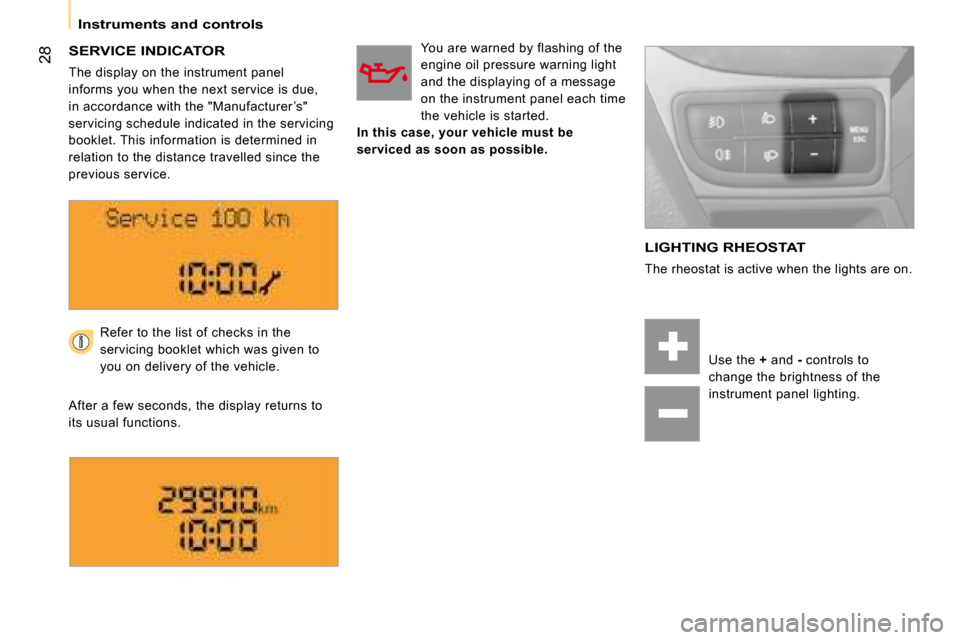
28
Instruments and controls
SERVICE INDICATOR
The display on the instrument panel
informs you when the next service is due,
in accordance with the "Manufacturer ’s"
servicing schedule indicated in the servicing
booklet. This information is determined in
relation to the distance travelled since the
previous service. You are warned by flashing of the
engine oil pressure warning light
and the displaying of a message
on the instrument panel each time
the vehicle is started.
In this case, your vehicle must be
serviced as soon as possible.
LIGHTING RHEOSTAT
The rheostat is active when the lights are on.
Refer to the list of checks in the
servicing booklet which was given to
you on delivery of the vehicle.
After a few seconds, the display returns to
its usual functions. Use the
+ and - controls to
change the brightness of the
instrument panel lighting.
Page 29 of 140
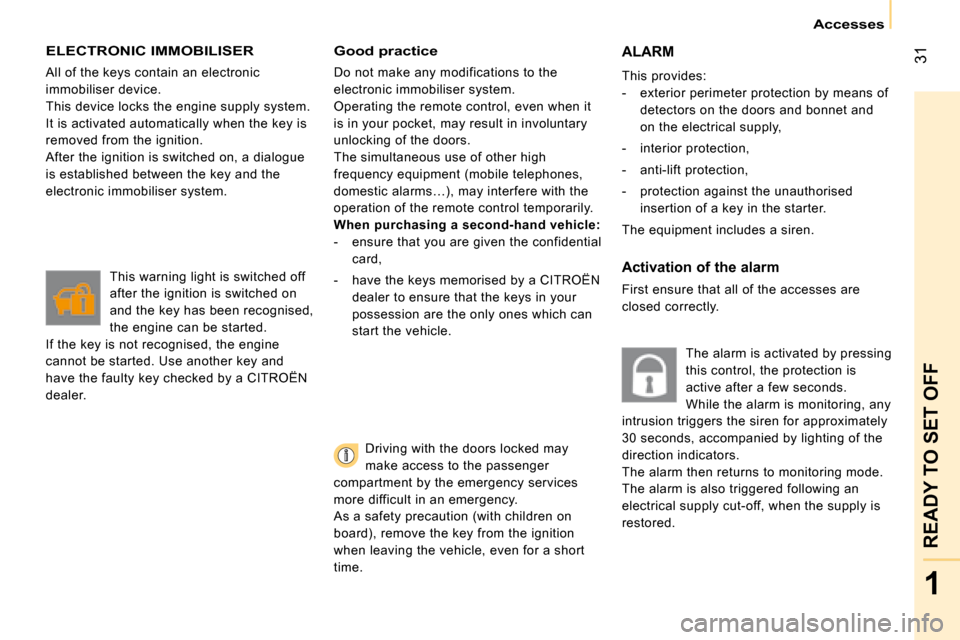
31
1
READY TO SET OFF
Accesses
ELECTRONIC IMMOBILISER
All of the keys contain an electronic
immobiliser device.
This device locks the engine supply system.
It is activated automatically when the key is
removed from the ignition.
After the ignition is switched on, a dialogue
is established between the key and the
electronic immobiliser system. This warning light is switched off
after the ignition is switched on
and the key has been recognised,
the engine can be started.
If the key is not recognised, the engine
cannot be started. Use another key and
have the faulty key checked by a CITROËN
dealer .
Good practice
Do not make any modifications to the
electronic immobiliser system.
Operating the remote control, even when it
is in your pocket, may result in involuntary
unlocking of the doors.
The simultaneous use of other high
frequency equipment (mobile telephones,
domestic alarms…), may interfere with the
operation of the remote control temporarily.
When purchasing a second-hand vehicle:
- ensure that you are given the confidential card,
- have the keys memorised by a CITROËN dealer to ensure that the keys in your
possession are the only ones which can
start the vehicle.
Driving with the doors locked may
make access to the passenger
compartment by the emergency services
more difficult in an emergency.
As a safety precaution (with children on
board), remove the key from the ignition
when leaving the vehicle, even for a short
time.
ALARM
This provides:
- exterior perimeter protection by means of detectors on the doors and bonnet and
on the electrical supply,
- interior protection,
- anti-lift protection,
- protection against the unauthorised insertion of a key in the starter.
The equipment includes a siren.
Activation of the alarm
First ensure that all of the accesses are
closed correctly.
The alarm is activated by pressing
this control, the protection is
active after a few seconds.
While the alarm is monitoring, any
intrusion triggers the siren for approximately
30 seconds, accompanied by lighting of the
direction indicators.
The alarm then returns to monitoring mode.
The alarm is also triggered following an
electrical supply cut-off, when the supply is
restored.
Page 32 of 140
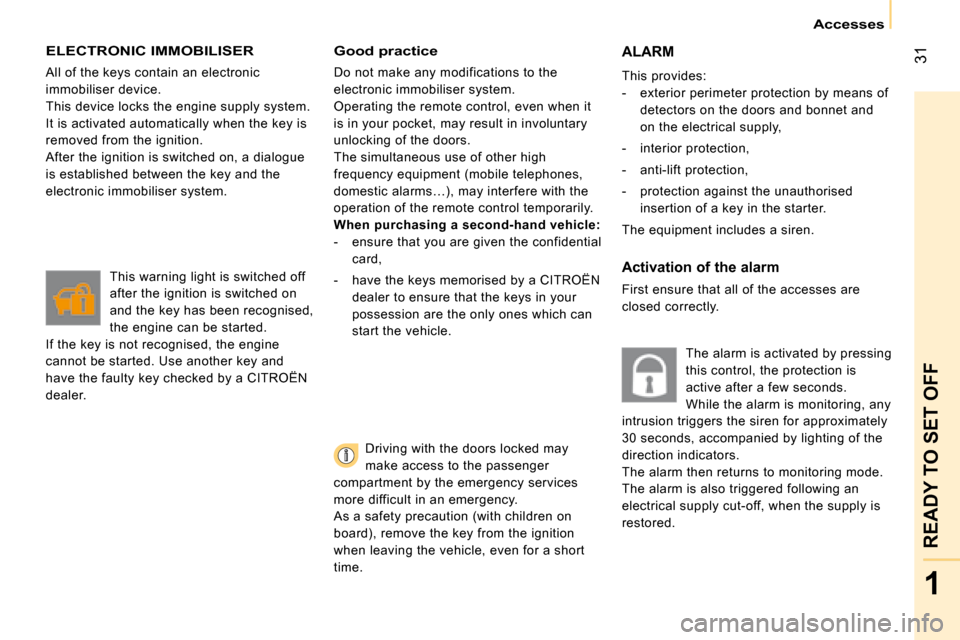
31
1
READY TO SET OFF
Accesses
ELECTRONIC IMMOBILISER
All of the keys contain an electronic
immobiliser device.
This device locks the engine supply system.
It is activated automatically when the key is
removed from the ignition.
After the ignition is switched on, a dialogue
is established between the key and the
electronic immobiliser system. This warning light is switched off
after the ignition is switched on
and the key has been recognised,
the engine can be started.
If the key is not recognised, the engine
cannot be started. Use another key and
have the faulty key checked by a CITROËN
dealer .
Good practice
Do not make any modifications to the
electronic immobiliser system.
Operating the remote control, even when it
is in your pocket, may result in involuntary
unlocking of the doors.
The simultaneous use of other high
frequency equipment (mobile telephones,
domestic alarms…), may interfere with the
operation of the remote control temporarily.
When purchasing a second-hand vehicle:
- ensure that you are given the confidential card,
- have the keys memorised by a CITROËN dealer to ensure that the keys in your
possession are the only ones which can
start the vehicle.
Driving with the doors locked may
make access to the passenger
compartment by the emergency services
more difficult in an emergency.
As a safety precaution (with children on
board), remove the key from the ignition
when leaving the vehicle, even for a short
time.
ALARM
This provides:
- exterior perimeter protection by means of detectors on the doors and bonnet and
on the electrical supply,
- interior protection,
- anti-lift protection,
- protection against the unauthorised insertion of a key in the starter.
The equipment includes a siren.
Activation of the alarm
First ensure that all of the accesses are
closed correctly.
The alarm is activated by pressing
this control, the protection is
active after a few seconds.
While the alarm is monitoring, any
intrusion triggers the siren for approximately
30 seconds, accompanied by lighting of the
direction indicators.
The alarm then returns to monitoring mode.
The alarm is also triggered following an
electrical supply cut-off, when the supply is
restored.
Page 34 of 140
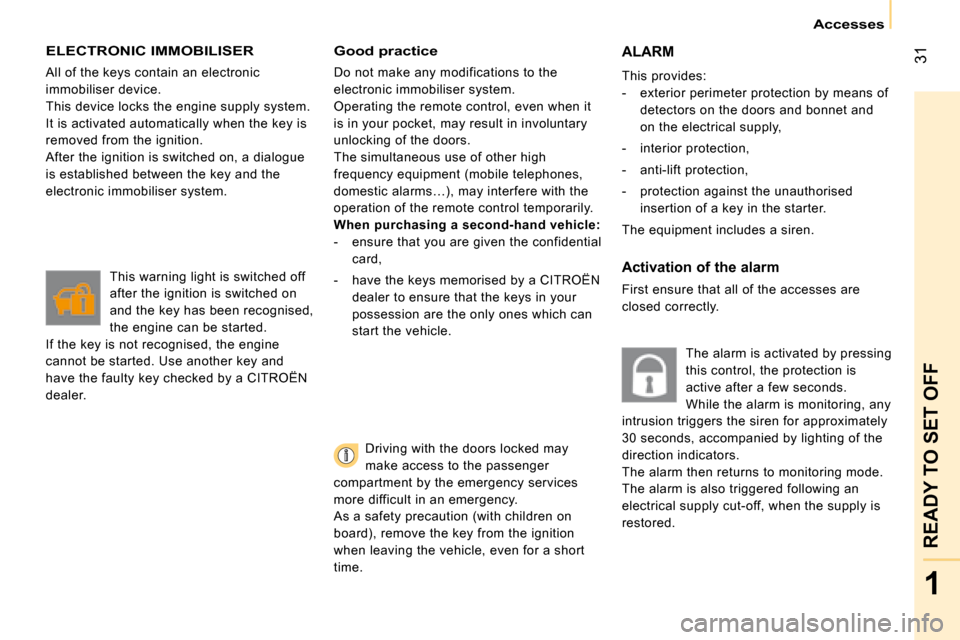
31
1
READY TO SET OFF
Accesses
ELECTRONIC IMMOBILISER
All of the keys contain an electronic
immobiliser device.
This device locks the engine supply system.
It is activated automatically when the key is
removed from the ignition.
After the ignition is switched on, a dialogue
is established between the key and the
electronic immobiliser system. This warning light is switched off
after the ignition is switched on
and the key has been recognised,
the engine can be started.
If the key is not recognised, the engine
cannot be started. Use another key and
have the faulty key checked by a CITROËN
dealer .
Good practice
Do not make any modifications to the
electronic immobiliser system.
Operating the remote control, even when it
is in your pocket, may result in involuntary
unlocking of the doors.
The simultaneous use of other high
frequency equipment (mobile telephones,
domestic alarms…), may interfere with the
operation of the remote control temporarily.
When purchasing a second-hand vehicle:
- ensure that you are given the confidential card,
- have the keys memorised by a CITROËN dealer to ensure that the keys in your
possession are the only ones which can
start the vehicle.
Driving with the doors locked may
make access to the passenger
compartment by the emergency services
more difficult in an emergency.
As a safety precaution (with children on
board), remove the key from the ignition
when leaving the vehicle, even for a short
time.
ALARM
This provides:
- exterior perimeter protection by means of detectors on the doors and bonnet and
on the electrical supply,
- interior protection,
- anti-lift protection,
- protection against the unauthorised insertion of a key in the starter.
The equipment includes a siren.
Activation of the alarm
First ensure that all of the accesses are
closed correctly.
The alarm is activated by pressing
this control, the protection is
active after a few seconds.
While the alarm is monitoring, any
intrusion triggers the siren for approximately
30 seconds, accompanied by lighting of the
direction indicators.
The alarm then returns to monitoring mode.
The alarm is also triggered following an
electrical supply cut-off, when the supply is
restored.
Page 35 of 140
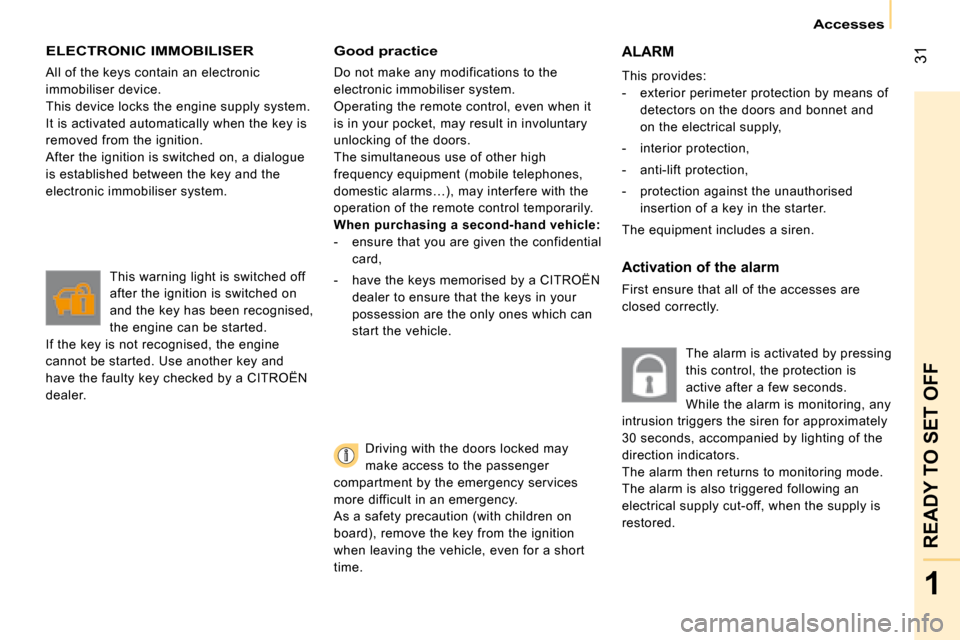
31
1
READY TO SET OFF
Accesses
ELECTRONIC IMMOBILISER
All of the keys contain an electronic
immobiliser device.
This device locks the engine supply system.
It is activated automatically when the key is
removed from the ignition.
After the ignition is switched on, a dialogue
is established between the key and the
electronic immobiliser system. This warning light is switched off
after the ignition is switched on
and the key has been recognised,
the engine can be started.
If the key is not recognised, the engine
cannot be started. Use another key and
have the faulty key checked by a CITROËN
dealer .
Good practice
Do not make any modifications to the
electronic immobiliser system.
Operating the remote control, even when it
is in your pocket, may result in involuntary
unlocking of the doors.
The simultaneous use of other high
frequency equipment (mobile telephones,
domestic alarms…), may interfere with the
operation of the remote control temporarily.
When purchasing a second-hand vehicle:
- ensure that you are given the confidential card,
- have the keys memorised by a CITROËN dealer to ensure that the keys in your
possession are the only ones which can
start the vehicle.
Driving with the doors locked may
make access to the passenger
compartment by the emergency services
more difficult in an emergency.
As a safety precaution (with children on
board), remove the key from the ignition
when leaving the vehicle, even for a short
time.
ALARM
This provides:
- exterior perimeter protection by means of detectors on the doors and bonnet and
on the electrical supply,
- interior protection,
- anti-lift protection,
- protection against the unauthorised insertion of a key in the starter.
The equipment includes a siren.
Activation of the alarm
First ensure that all of the accesses are
closed correctly.
The alarm is activated by pressing
this control, the protection is
active after a few seconds.
While the alarm is monitoring, any
intrusion triggers the siren for approximately
30 seconds, accompanied by lighting of the
direction indicators.
The alarm then returns to monitoring mode.
The alarm is also triggered following an
electrical supply cut-off, when the supply is
restored.
Page 51 of 140
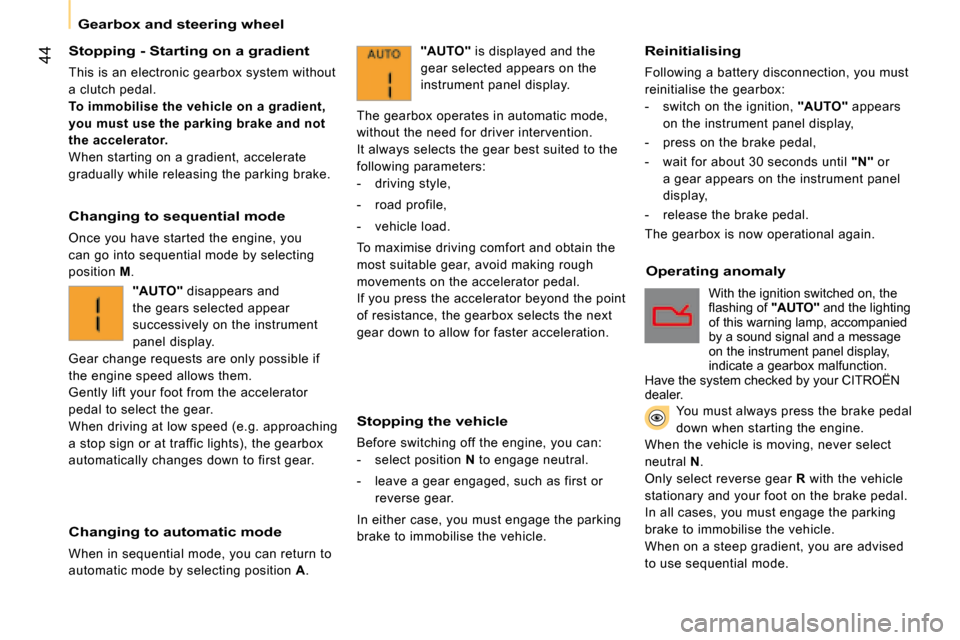
44
Gearbox and steering wheel
Stopping - Starting on a gradient
This is an electronic gearbox system without
a clutch pedal.
To immobilise the vehicle on a gradient,
you must use the parking brake and not
the accelerator.
When starting on a gradient, accelerate
gradually while releasing the parking brake.
Changing to sequential mode
Once you have started the engine, you
can go into sequential mode by selecting
position M.
Changing to automatic mode
When in sequential mode, you can return to
automatic mode by selecting position A.
Stopping the vehicle
Before switching off the engine, you can:
- select position N to engage neutral.
- leave a gear engaged, such as first or
reverse gear.
In either case, you must engage the parking
brake to immobilise the vehicle.
Reinitialising
Following a battery disconnection, you must
reinitialise the gearbox:
- switch on the ignition, "AUTO" appears
on the instrument panel display,
- press on the brake pedal,
- wait for about 30 seconds until "N" or
a gear appears on the instrument panel
display,
- release the brake pedal.
The gearbox is now operational again.
Operating anomaly
"AUTO" is displayed and the
gear selected appears on the
instrument panel display.
The gearbox operates in automatic mode,
without the need for driver intervention.
It always selects the gear best suited to the
following parameters:
- driving style,
- road profile,
- vehicle load.
To maximise driving comfort and obtain the
most suitable gear, avoid making rough
movements on the accelerator pedal.
If you press the accelerator beyond the point
of resistance, the gearbox selects the next
gear down to allow for faster acceleration.
"AUTO" disappears and
the gears selected appear
successively on the instrument
panel display.
Gear change requests are only possible if
the engine speed allows them.
Gently lift your foot from the accelerator
pedal to select the gear.
When driving at low speed (e.g. approaching
a stop sign or at traffic lights), the gearbox
automatically changes down to first gear.
With the ignition switched on, the �fl� �a�s�h�i�n�g� �o�f� "AUTO" and the lighting of this warning lamp, accompanied by a sound signal and a message on the instrument panel display, indicate a gearbox malfunction.Have the system checked by your CITROËN dealer.You must always press the brake pedal
down when starting the engine.
When the vehicle is moving, never select
neutral N.
Only select reverse gear R with the vehicle
stationary and your foot on the brake pedal.
In all cases, you must engage the parking
brake to immobilise the vehicle.
When on a steep gradient, you are advised
to use sequential mode.
Page 111 of 140
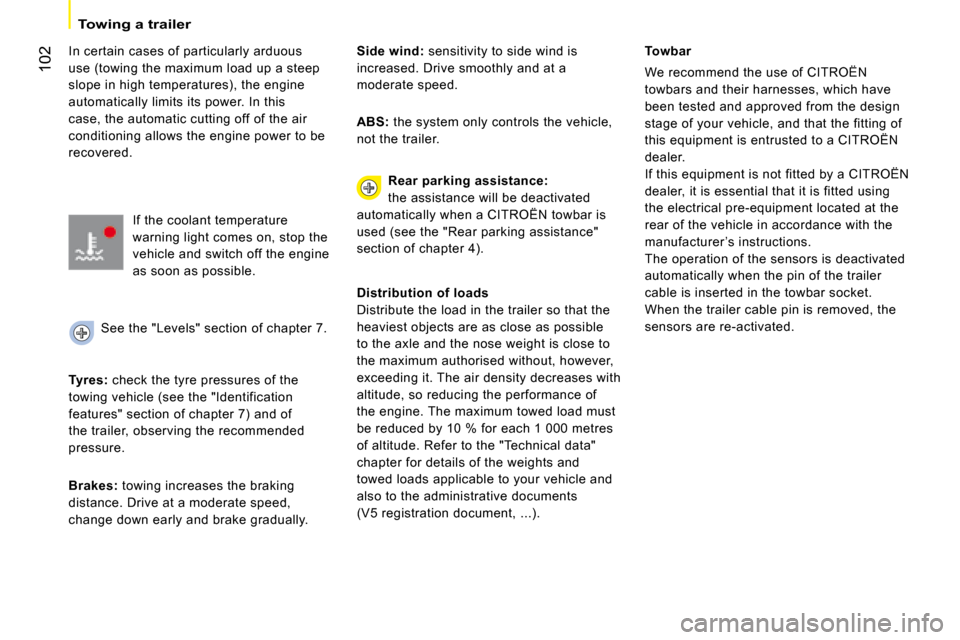
102
Towing a trailer
In certain cases of particularly arduous
use (towing the maximum load up a steep
slope in high temperatures), the engine
automatically limits its power. In this
case, the automatic cutting off of the air
conditioning allows the engine power to be
recovered. If the coolant temperature
warning light comes on, stop the
vehicle and switch off the engine
as soon as possible.
See the "Levels" section of chapter 7.
Tyres: check the tyre pressures of the
towing vehicle (see the "Identification
features" section of chapter 7) and of
the trailer, observing the recommended
pressure.
Brakes: towing increases the braking
distance. Drive at a moderate speed,
change down early and brake gradually.
Side wind: sensitivity to side wind is
increased. Drive smoothly and at a
moderate speed.
ABS: the system only controls the vehicle,
not the trailer.
Rear parking assistance:
the assistance will be deactivated
automatically when a CITROËN towbar is
used (see the "Rear parking assistance"
section of chapter 4). Towbar
We recommend the use of CITROËN
towbars and their harnesses, which have
been tested and approved from the design
stage of your vehicle, and that the fitting of
this equipment is entrusted to a CITROËN
dealer .
If this equipment is not fitted by a CITROËN
dealer , it is essential that it is fitted using
the electrical pre-equipment located at the
rear of the vehicle in accordance with the
manufacturer ’s instructions.
The operation of the sensors is deactivated
automatically when the pin of the trailer
cable is inserted in the towbar socket.
When the trailer cable pin is removed, the
sensors are re-activated.
Distribution of loads
Distribute the load in the trailer so that the
heaviest objects are as close as possible
to the axle and the nose weight is close to
the maximum authorised without, however,
exceeding it. The air density decreases with
altitude, so reducing the performance of
the engine. The maximum towed load must
be reduced by 10 % for each 1 000 metres
of altitude. Refer to the "Technical data"
chapter for details of the weights and
towed loads applicable to your vehicle and
also to the administrative documents
(V5 registration document, ...).